Archival Show and Tell #7
Not Those Blue Mustangs
Again!!!
by Dana Bell
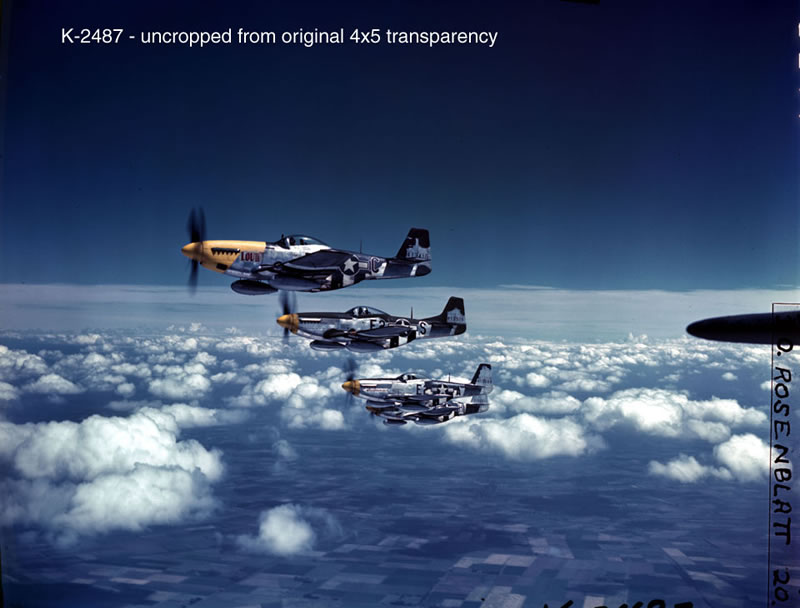

HyperScale is proudly supported by Squadron
Not those Blue Mustangs Again!!! |
We’ve seen many arguments (or as we tell our children, “discussions”) regarding the colors seen on 361st Fighter Group Mustangs during the summer of 1944. Spotters who visited the unit at that time noted that many of the aircraft were painted with blue on the upper surfaces; years later, unit veterans disputed that claim, insisting that all the aircraft were painted Olive Drab. A famous series of aerial photos could have settled the matter, but minor color shifts in photographic and published reproductions did little more than add to the confusion.
In the mid-1990s I hoped to find an answer by reviewing the surviving original 4x5 Kodachrome transparencies, using an 8-power lupe and a daylight-balanced light table. The results were inconclusive – I could see that some aircraft were green, and that others were a different, darker color that I couldn’t classify as a green, black, gray, or blue.
Still, I felt it important to include a photo of the aircraft in an upcoming book on the history of OD/Neutral Gray camouflage, and requested the surviving images be pulled at the National Archives at College Park, Maryland. In one of the most generous actions I’ve seen in years, “Archives 2" has purchased an expensive, extra-large format transparency scanner for the use of visiting researchers – you load their software into your laptop, plug into the scanner, and copy up to ten original transparencies or negatives per day. “Perfect,” I thought – make high res copies for the book, add a caption that explains the controversy, and leave out any opinions.
I started with a single image.
K-2487 – Many of the original Kodachromes have long since gone missing – stolen, lost, or perhaps just misfiled. But I was fortunate that my first choice for the book – the classic shot of four 375th FS Mustangs often known as the Bottisham Four – survived as an original, near-perfect, 73-year-old 4x5 transparency. Always a believer in high resolution scanning, I shot the image (seen at the top of the page) at 1200 dots per inch. I then used PhotoShop’s cropping software to zoom in on the aircraft, making a second scan at 3200 dpi. That evening I straightened the scans, trimmed away any borders outside of the image, and (in the case of my cropped scan) lightened the image about 15% to soften the shadows beneath the aircraft. (Please note, there were no “color corrections” – I simply lightened the image to prepare it for publication.) The results are seen here:
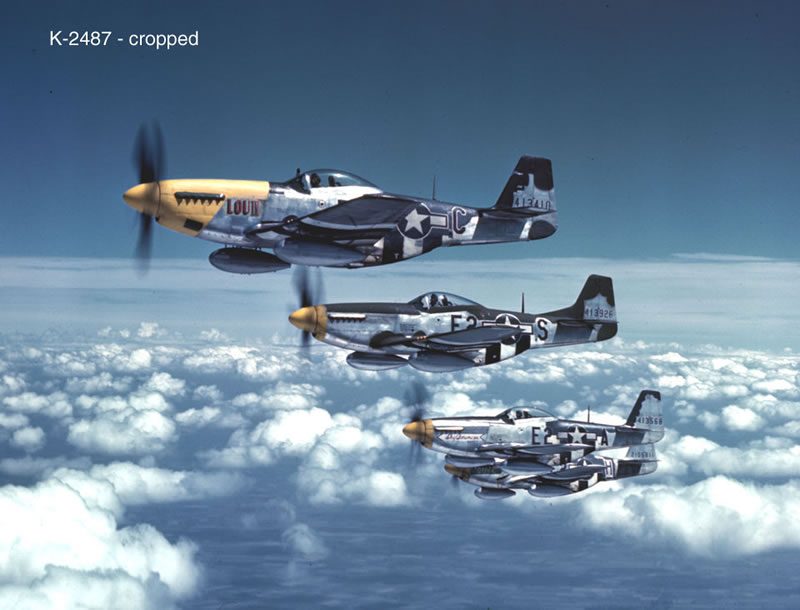
It took me at least a second to move from “that’s strange” to “wait a minute..” to “Sierra Hotel - she really WAS blue!” Further, the blue is clearly distinguishable from the green atop and below the tail. While the green seemed a good match for the green on E2*S, the other aircraft (E2*A and E2*H) appear to be the same blue seen on Lou IV.
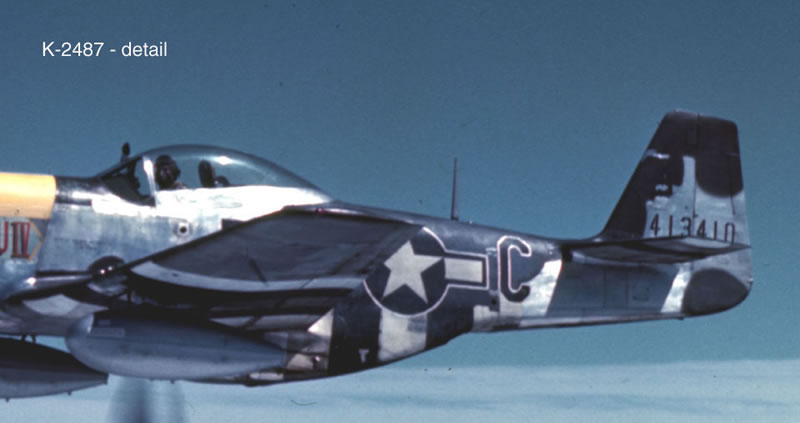
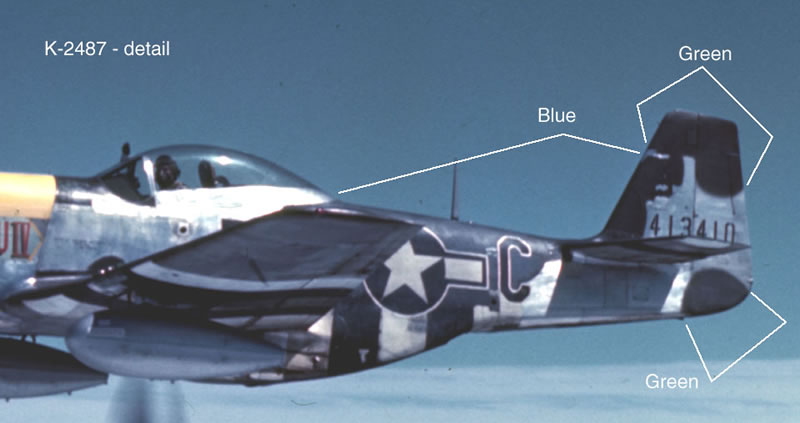
But why would the 361st use two colors? Soon after D-Day, Supreme Headquarters Allied Expeditionary Forces (SHAEF) allowed units to remove invasion stripes from the upper surfaces of their aircraft. Though some units scrubbed the stripes off, others overpainted them. For some reason long since forgotten by surviving 361st veterans, many, if not all of the unit’s aircraft received a blue camouflage of unknown origin. The photo below of Bald Eagle shows the effect of camouflage covering the invasion stripes only:

At some point the 361st added camouflage to all upper surfaces. Perhaps the source of blue paint had dried up, perhaps the unit decided green was a more appropriate upper surface camouflage – in any event the tops of outer wing panels and stabilizers, along with portions of the vertical tail, were painted either OD or possibly RAF Dark Green. In some cases the blue surfaces might have been overpainted too, though Lou IV certainly kept both colors. This black and white image shows a tonal difference outboard of the overpainted wing stripes, and again at the wingtip. (The color images above suggest that the wingtips may have been painted blue on this aircraft.
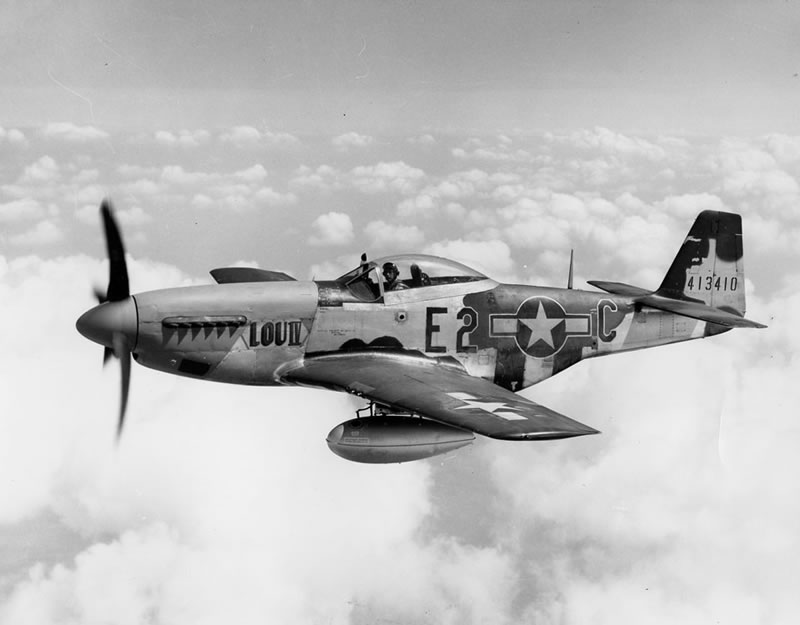
As the summer wore on, the 361st replaced its remaining P-51Bs with new P-51Ds. E2*S was one of these replacements, arriving from depot after the decision to omit invasion stripes from upper surfaces, there was never an opportunity to cover those stripes with blue. As the color shot above and this B&W image show, the aircraft’s upper surfaces were camouflaged overall with green paint. Eventually, all of the older blue-painted aircraft would have been replaced or lost in combat – Lou IV was shot down on 12 August 1944 – and unit members would have seen only green camouflage. (This may help explain why veterans insist that the blue was never used.)

With one color image showing blue on three aircraft, I returned to the Archives, to pull all remaining color images of the 361st’s Mustangs. Here is what I found:
K-2488 – an original transparency that was marked “Rosenblatt 24" when I studied it some two decades ago, this was an image was similar to K-2487. Unfortunately, today the Archives has no trace of the original or any copies.
K-2489 – again, the original is missing, though a 35mm copy slide survives. The increased contrast has messed with the colors, and I see no value for color identification. When I reviewed the original transparency more than 20 years ago, I noted that even then the image was of very poor quality:
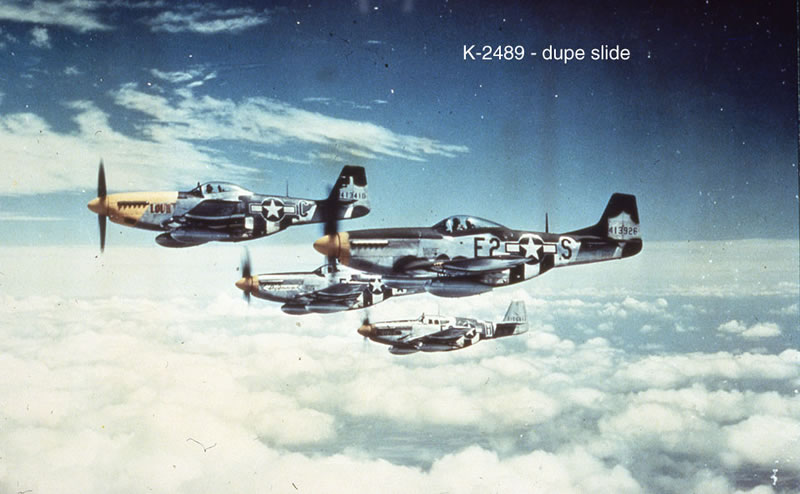
K-2667 – the famous, oft-published image of Lou IV is no longer at the Archives, and has been missing since at least 1976. A duplicate transparency and three copy negs have survived, each with varying color quality. The dupe transparency and two copy negs are of poor quality; the third neg is slightly better, and shows more of the original image than the other three, but none shows the blue on the fuselage or the green on the tail. (Truly a shame – it would have been nice to see the colors as they appeared on the wings and stabilizers!):
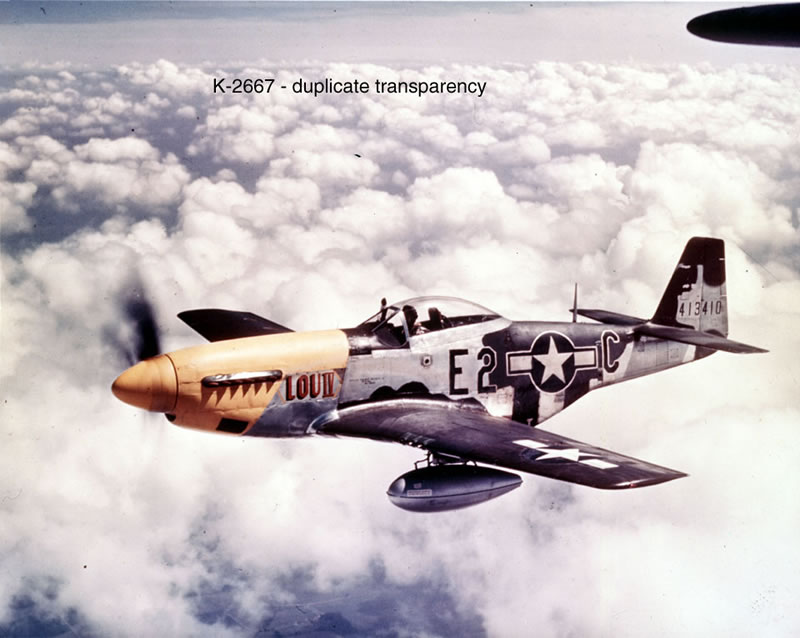
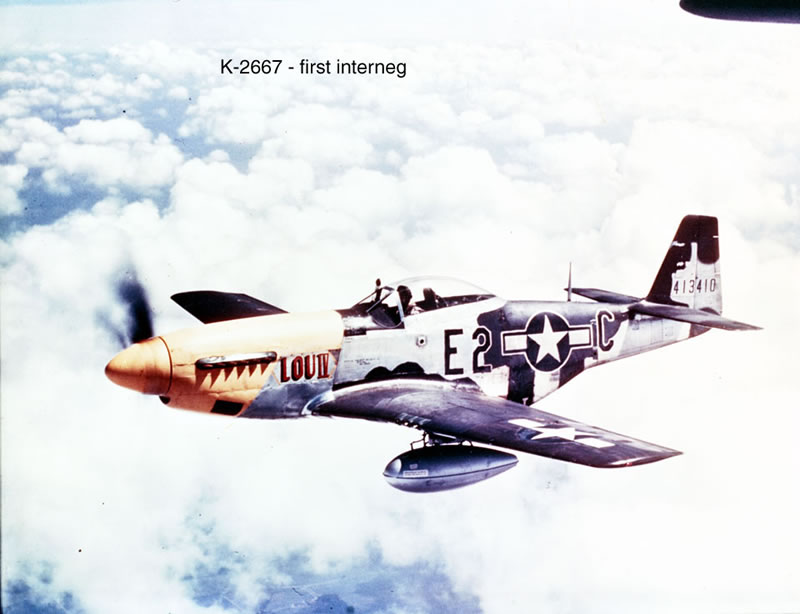
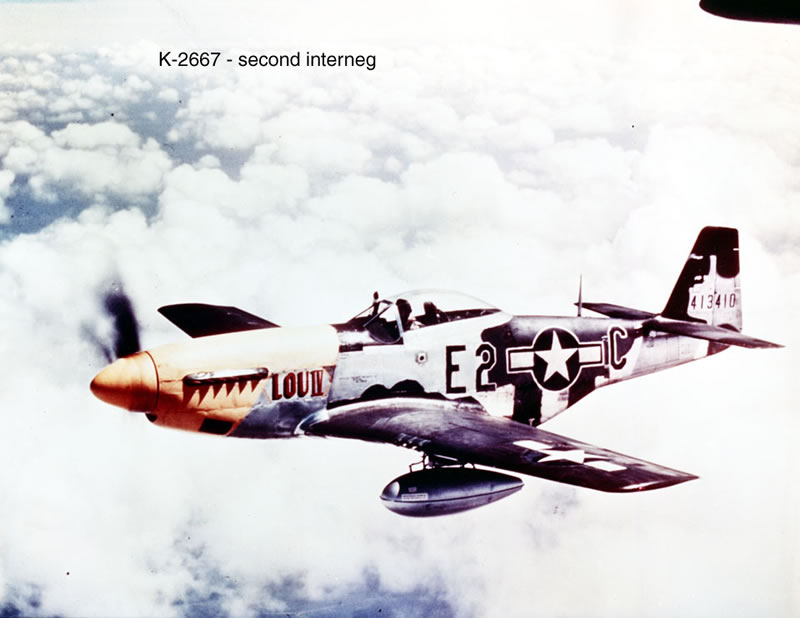
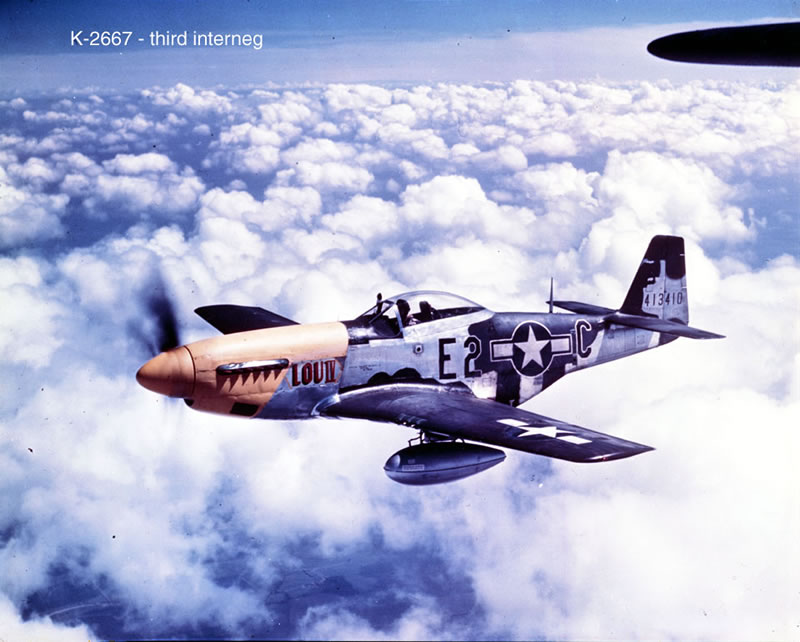
K-2275 – From the 376th FS, this image of E9*O is reputed to be the original transparency. However, the high contrast suggests we’re looking at another dupe. Either way, the contrast of this image makes it useless as a record of how the aircraft was painted:
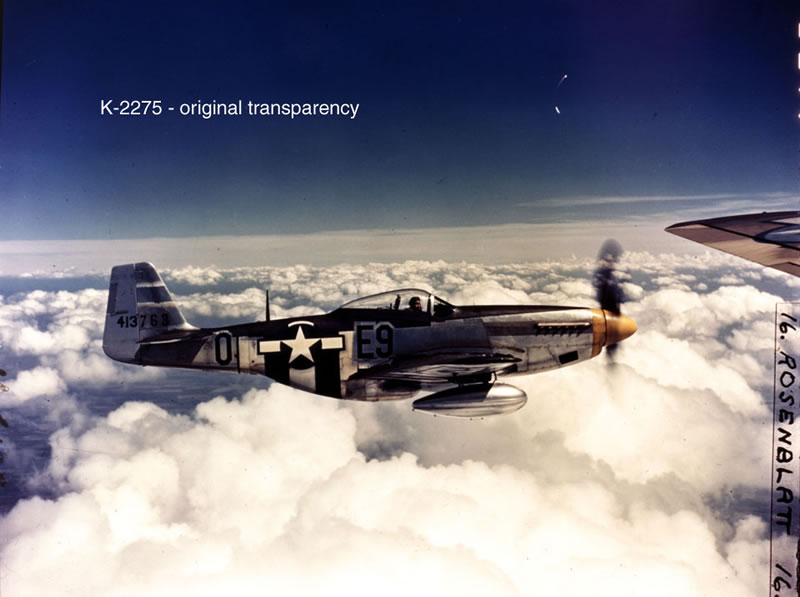
K-2478 – Ferocious Frankie is the subject of this beautiful original 4x5 Kodachrome. The color above the invasion stripes cannot be determined in this view; manipulation of the brightness shows only a dark color with no hint of blue or green. Perhaps black or gray was used, or perhaps the true color is lost in the sun’s reflection.

K-2482 – Again an original transparency is missing; Tika IV was scanned from a 4x5 copy neg. This 374th FS aircraft’s upper surface invasion stripes were not overpainted with blue or green – they were sprayed with aluminum lacquer or possibly (on the fuselage) scrubbed away. The image does display blue tips on the wings and tail planes – in this case possibly used as a squadron color.
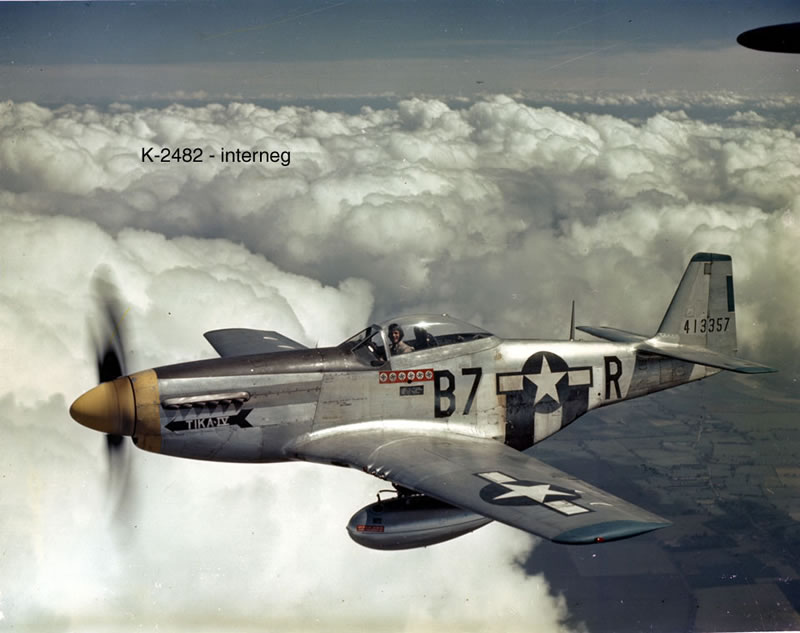
For years the argument “It looks green in my photo (or slide, or publication)” has seemed adequate proof that the 361st did not use blue camouflage. Indeed, in many copies the colors do look green, but those copies have all suffered from the quality of the surviving source images and the color shifts of copy film or publishers’ color separations.
Out of six surviving color images of the 361st’s Mustangs in flight, only three images are original Kodachromes, and only one of those shows the much-disputed Bottisham Four. That image, when lightened, shows the green on the tail of Lou IV, but also clearly shows the blue camouflage on that aircraft and two others. Today’s new argument must be that the only clear original image of the four aircraft clearly shows blue paint on three of the aircraft, green on the fourth, and additional patches of green on the first blue aircraft. Two other originals (one of which may be a dupe) show invasion stripes overpainted in a color that cannot be identified as green or blue.
For the purposes of this article, all of my scanned high resolution tiffs have been reduced to lower resolution jpegs. If you wish to review the images I scanned, they are currently stored at National Archives 2 in College Park. Use the “K” numbers when ordering (no later than 10:30 each morning); the Record Group is 342-FH. It will take a few hours for the images to warm to room temperature, but you can usually begin studying or scanning around 1:15.
I’d like to think this will end the long-standing argument against the use of blue, though I suspect nothing could be that easy. Regardless, I hope this effort helps define the modeler’s choices – and how you paint your own model will always be your own choice...
Text and Images Copyright ©
2018 by Dana Bell
Page Created 29 January, 2018
Last Updated
29 January, 2018
Back to Reference Library |
Home |
What's New |
Features |
Gallery |
Reviews |
Reference |
Forum |
Search